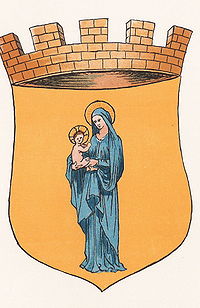Lauder
Lauder
|
|
|---|---|
 Lauder Burgh Arms |
|
| Lauder shown within the Scottish Borders | |
| OS grid reference | NT530475 |
| Council area | |
| Lieutenancy area | |
| Country | Scotland |
| Sovereign state | United Kingdom |
| Post town | Lauder |
| Postcode district | TD2 |
| Police | Scottish |
| Fire | Scottish |
| Ambulance | Scottish |
| EU Parliament | Scotland |
| UK Parliament | |
| Scottish Parliament | |
The Royal Burgh of Lauder (Scottish Gaelic: Labhdar) is a town in the Scottish Borders in the historic county of Berwickshire. On the Southern Upland Way, the burgh lies 27 miles south east of Edinburgh, on the western edge of the Lammermuir Hills.
Although Lauder sits in the valley of Leader Water, Watson notes that the names Lauder and Leader appear to be unconnected. In the earliest sources Lauder appears as Lauuedder and Louueder.
Below Lauder are the lands of Kedslie which were bounded on the west by a road called "Malcolm's rode," and it is thought this formed part of the Roman road known as Dere Street, which passed through Lauder. Hardie suggests that it had been reconditioned by Malcolm III for use in his almost constant warfare against England. It is the only old road in Scotland that is associated with the name of an individual person.
The ancient settlement was further up the hills on the edge of the Moor. Its name is unknown, but it was tiny. The New Statistical Account of Scotland (vol.II) says that the present town of Lauder existed as a kirk-town in the time of David I (1124–53), and Sir J.D.Marwick says, in his preface to the Records of Convention, that the present town of Lauder existed in the latter half of the twelfth century. The town was once surrounded by walls with gates commonly referred to as 'ports'. Two major mills, which dated from the 12th century, also served the town.
With the introduction of the feudal system to Scotland by David I, a provincial Lordship of Regality of Lauderdale, had been created for the King's favourite, Hugh de Morville (who founded Dryburgh Abbey), which covered an extensive amount of territory, although Thomson states that the family of de Lawedre were "there in the previous century." About 1170 Richard de Morville, Constable of Scotland, made a donation to the Brethren of the Hospital at Lauder, in 1245 a chapter of the clergy of East Lothian met at Lauder, and between 1248-52 Emericus is recorded as Rector of Lauder.
...
Wikipedia

